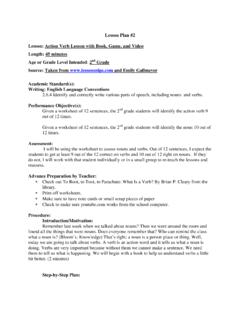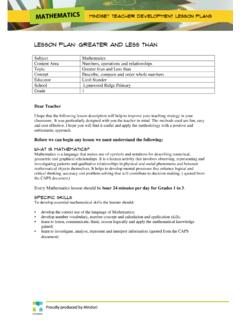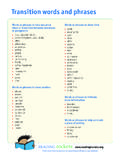Transcription of Lesson Plan on Energy, 3rd Grade Science
1 energy 3rd Grade Science Unit Length of Unit 7 days Bronka Lawhorn Summer 2005. NHMFL. Outline I. energy Sources II. energy Activities III. Heat/Color Relationships IV. Wasting energy at Home Sunshine State Standards: : The student knows that common materials ( , water) can be changed from one state to another by heating and cooling. The student understands that physical changes in the states of matter can be produced by heating and cooling. : The student recognizes various forms of energy ( , heat, light, and electricity). The student knows objects that emit heat and light. : The student recognizes various forms of energy ( , heat, light, and electricity). The student knows different forms of energy (for example, heat, light, sound). : The student knows that most things that emit light also emit heat.
2 The student knows that the Sun provides energy for the Earth in the form of heat and light. : The student knows the many ways in which energy can be transformed from one type to another. The student knows that heat can be produced by chemical reactions, electrical machines, and friction. : The student knows ways that heat can move from one object to another. The student knows that when a warmer object comes in contact with a cooler one, the warm object loses heat and the cool one gains it until they are both at the same temperature. : The student recognizes the costs and risks to society and the environment posed by the use of nonrenewable energy . The student knows ways natural resources are important. Day 1 - energy Sources Objectives: The third Grade students will observe different types of energy sources.
3 They will learn more about energy and where it comes from. Background information: Sources of energy are all around us, and come in a variety of different forms. energy for a person is different than energy for an automobile. Materials: Picture of the sun Fruit or vegetable Piece of firewood Piece of charcoal or coal Container of motor oil Gas lighter Cup of water and an empty cup Child's pinwheel Picture of lightning or a light bulb Picture of a nuclear power plant Piece of discarded trash Battery Worksheet #1 energy Sources (Assessment - one for each student). Procedures: 1. Display all of the items on a table and ask the students which they think are a source of energy . 2. Each item should be labeled (an index card with title on one side and detailed description on the other side) with a card in front of it.
4 (Number the cards with corresponding numbers on items). 3. After students take turns guessing, go over every item individually and give full description to class. Extensions/Modifications 1. Assign the energy words as a homework vocabulary assignment to your students. Have students complete sentences using the words. 2. To extend this activity, have each student write a one-page essay on which three energy sources they would choose as the best sources of energy for the world. Tell them to explain why they chose what they did. This can be given as an in-class assignment or as a homework assignment. When the essays have been completed, ask some students to read theirs aloud. Display the completed essays in the classroom. Summary: Remind the students that sources of energy are all around us and come in a variety of different forms.
5 Review the day's Lesson and ask for questions. Tell the students that tomorrow they will participate in activities to learn how energy works in our world. Assign worksheet #1- energy Sources. Assessment: Pass out the Worksheet #1 energy Sources to each student. Read the questions out loud but have them work individually. Call upon students to provide answers and allow students to correct papers. Collect for daily Science Grade . Name:_____Date:_____. energy Sources wind natural gas chemical sun nuclear water refuse-derived fuel food electrical coal 1. The light that comes to earth from the _____ is pure energy . 2. One of the three fossil fuels, _____ is burned to heat homes and run electrical machinery. 3. _____ that blows can be used to turn windmills, which generate electricity.
6 4. _____ is the source of energy used by people. The stored energy is used by the body to keep the heart beating, the blood pumping and the body growing. 5. _____ falling downhill is used to run turbines, which generate electricity. This is called hydroelectric power. 6. A storm contains a great deal of natural _____ energy . 7. Batteries create energy through _____ reactions. 8. _____ power produces far more power per ton than any other energy source. It does not contribute to air pollution. The drawback to this power is finding a safe place to dispose of the waste. 9. _____ is discarded trash that is burned in a waste-to- energy facility. As it burns, water pipes are heated and this hot water is used to generate electricity. 10. _____ is a fossil fuel used to heat many homes and is also found in lighters.
7 energy Sources - fossil fuels sunlight food wood coal oil natural gas water wind electricity nuclear power chemical energy refuse-derived fuel Sunlight The light that comes to the earth from the sun is pure energy . The sun is the original energy source. Nearly all other sources of energy originally got their energy from the sun. Organic matter, like plants, convert solar energy into leaves, flowers and fruits. Animals, which eat organic matter, convert the energy into body mass. When animals die, their energy is decomposed and over extensive time, becomes stored as oil, coal or natural gas. Food Food is the source of energy used by people. Food that we eat is digested, and the stored energy is used by the body to keep the heart beating, the blood pumping and the body growing.
8 When a body has low blood sugar , the body needs to eat and process more energy , so we can continue working, playing and growing. Wood Wood comes from trees, which are, of course, plants. The plants got their energy from the sun. When trees are cut down and burned, they release their energy in the form of heat. Many homes are heated with wood-burning stoves or fireplaces. Fossil Fuels Coal, oil and natural gas are the three energy sources that come from prehistoric fossils. Like the methods described in wood, ancient plants absorbed the energy from the sun and converted it into more plants. Ancient animals, like dinosaurs, ate the plants. When the plants and animals died, their remains collected under mountains of earth and, over millions of years, they decomposed into a source of fuel.
9 The remains of these plants and animals are what we refer to as fossil fuels. Coal Coal is burned to heat homes and run electrical machinery. About 20% of the energy we use comes from coal. Oil Hold up a container of motor oil. Other petroleum products similar to motor oil are burned to fuel motor vehicles and heat homes. About 45% of energy comes from oil. Natural Gas Natural gas is used to heat the homes of many people. About 25% of the energy we use comes from natural gas. The fuel used in lighters is not the same as the natural gas used to heat homes, but the lighter can be used as an example. Water Water is not an energy source, but water is used to generate energy . Water falling downhill is used to run turbines, which generate electricity.
10 This is called hydroelectric power. About 5% of the world's power is now produced by hydroelectric dams. A similar type of energy comes from geothermal energy . Pockets of boiling water under the earth's surface send steam to the surface of the earth. This hot water also can be used to generate electricity. Dams can impede the movement of fish up and down river to reach spawning grounds or for other migratory purposes. Wind Winds that blow can be used to turn windmills, which generate electricity. Windmills have been used for centuries in some parts of the world, like Holland. Windmills are also used in the United States. Electricity An electrical storm contains a great deal of natural electrical energy . Benjamin Franklin first proved that lightning was electricity in 1752.






